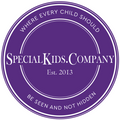
Teaching autistic children personal space and boundaries
Our top tips on how to teach kids about personal space
For some children with autism, it can be difficult to understand personal space and boundaries, which relates to them and the people around them. It’s important to try and teach your child about personal space and physical boundaries because it will help them to socialise with others and feel comfortable in their own bodies. Likewise, it will help others to socialise and feel comfortable around them.

Use a social story to explain personal space and boundaries
Using a social story can be so helpful in teaching boundaries and personal space to a child with autism. There are lots available on the internet but you can also create your own, catering it to your child’s needs. Social stories help autistic children to break down information, process, and understand it. You can explain what personal space is and what good and bad personal space looks like. You can then explain to your child why people have boundaries and what social cues to look for.
Illustrate personal space and boundaries by using visual cues
Visual cues, such as PECS or objects, can be a great tool for explaining boundaries to children with autism. Some recommend using a big ball or a hula hoop to explain the need for space between one person and another. You can also use PECS to let your child know when they are pushing boundaries or invading a person’s personal space.
Teach them body language
Try to teach your child the social cues for body language, for example, another child might push them away if they are too close to them. Another person might look upset or back away from them.
Show them what good personal space and boundaries are
You can do this by telling them a story or modelling this behaviour yourself. You could even video it and different examples and reactions to help them to understand. Show them what it is like to be ‘too close’ to help them understand and explain what language people might use if they are in their personal space, for example ‘you are too close to me’ or ‘move away’.
Create a safe, calming space for your child
This is not only a good place for your child to retreat to when they are feeling overwhelmed or in need of some quiet time, but it can also help them to understand personal boundaries by demonstrating to them some places in the house are just for them as are other spaces for other family members, like bedrooms.
Carry out some personal space activities
There are lots of activities that you can carry out to teach your child personal space and boundaries. One is by using carpet squares. These can be used at home or at school and provide children with a personal space to sit. They can also be used to line up for activities.
As previously mentioned, beach balls or hula hoops are a great way to demonstrate personal space and can be lots of fun too.
Praise your child when they recognise personal space and boundaries
Learning personal space and recognising boundaries takes time and may not come naturally to your child. It’s important to praise them when they start to acknowledge these boundaries to reinforce the behaviour and let them know that you are proud of what they are doing.

